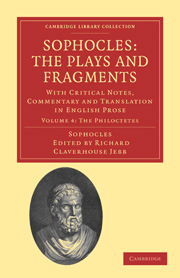METRICAL ANALYSIS
Published online by Cambridge University Press: 05 October 2010
Summary
In addition to anapaests, the lyric metres used in the Philoctetes are the following.
(1) Logaoedic, based on the choree (or ‘trochee’), − ⌣, and the cyclic dactyl, which is metrically equivalent to the choree, −⌣ ⌣. A logaoedic tetrapody, or verse of four feet (one cyclic dactyl and three chorees) is called ‘Glyconic’ According as the dactyl comes first, second, or third, the verse is a First, Second, or Third Glyconic. A logaoedic tripody (one cyclic dactyl and two chorees) is called ‘Pherecratic.’ According as the dactyl comes first or second, it is a First or Second Pherecratic. Logaoedic verses of six and of five feet also occur. The logaoedic dipody (‘versus Adonius’) is found once in this play: see Analysis, No. III., Stasimon, Second Strophe, per. II., v. 2.
(2) Choreic verses, based on the choree, − ⌣, are ordinarily of four or of six feet, and are often used to vary logaoedic measures (cp. No. I., Parodos, First Strophe, etc.).
(3) Dactyls occur in the form of the hexameter, the tetrapody, and the tripody. (For the two latter, see Analysis, No. IV., Kommos, First Strophe, per. 1.)
(4) Dochmiacs. The single dochmius, ⌣ ⋮ − − ⌣ | − ∧ ∥, occurs in No. V., Second Kommos, First Str., per. III., V. I. The dochmiac dimeter, of which the normal form is ⌣ ⋮ − − ⌣ | −, ⌣ ∥ − − ⌣ | − ∧ ∥, appears in No. II., Hyporcheme, periods II. and III., and in No. IV., Kommos, Strophe, per. III.
- Type
- Chapter
- Information
- Sophocles: The Plays and FragmentsWith Critical Notes, Commentary and Translation in English Prose, pp. xlviii - lxviiPublisher: Cambridge University PressPrint publication year: 2010First published in: 1890



